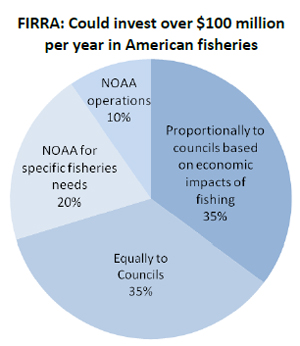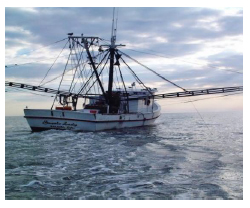The Fisheries Investment Act
Investing in America's Fishermen and Sustainable Fisheries
What is the FIA?
The FIA is new legislation that would provide dedicated funding to support the research, monitoring and management programs critical to sustaining ocean fish resources and fishing communities. The bill would restore the original uses of an existing revenue stream derived from duties on imported fish products – valued at an estimated $124 million for FY 2013 – to invest directly in the management of our nation's ocean fisheries.
What does the FIA do?
The bill would create a regional grant program that would direct 70 percent of those funds annually (an estimated $85 million in FY 2013) for vital fisheries management programs, and requires the development of regional fishery investment plans to ensure that funds target important local needs.
What kinds of programs would be eligible for funding?
- Stock assessments and surveys
- Cooperative research involving fishermen, academic institutions, and federal scientists
- Data collection for recreational fisheries
- Testing and deployment of environmentally friendly fishing gear
- Dockside, at sea, and electronic monitoring and reporting of commercial and recreational catch
- Assistance to and investments in fishermen and fishing communities through permit banks, marketing, and other activities to help sustain fishing communities
- Social and economic research
- Habitat restoration and protection
- Development of technologies and methods that improve the quality of fish landing
How would this bill ensure that fishermen and coastal communities benefit?
FIA would direct the regional fishery management councils to establish fishery investment committees comprised of commercial and recreational fishing interests; representatives from relevant local, state, federal and tribal (where applicable) agencies and interstate commissions; academic institutions; and representatives of the public with knowledge of the region's fisheries issues. These committees would develop regional fishery investment plans grounded in the specific management and research needs of each region. Funding decisions would be based on the priorities outlined in each plan.
How would grants be funded?
The Secretary of Commerce would administer the grant program for the eight fishery management councils. Each of the councils' fishery investment committees would review and make recommendations on which grant proposals to fund based on the priorities of their regional fishery investment plans, with final approval provided by the relevant regional council and the Secretary.
What else would the bill do to promote healthy fish populations and fishing businesses?
In addition to the regional grant program, funds would be available to support special fisheries needs and problems including management of highly migratory species, seafood promotion, mitigating fisheries disasters, regional fisheries commissions, and general National Oceanic and Atmospheric Administration (NOAA) operations (capped at 10 percent).
 How would funds be allocated?
How would funds be allocated?
Funds for this bill would be derived from the 1954 Saltonstall-Kennedy Act (S-K Act), which was originally intended to promote the U.S. seafood industry and is capitalized through annual transfers of 30 percent of the gross duties on imported fish and fish products. Over the past three decades, 88 percent of these funds have been diverted into NOAA's general operating account.
Total S-K funding averaged $101 million over the last five years, with $124 million estimated in the President's FY13 budget. Of this, up to six percent ($13 million in FY13) would be used for administration by the Secretary of Commerce and the councils. Seventy percent of the remaining funds would be used for the regional grant program. Of these funds, half would be allocated equally among councils, and half would be allocated based on the economic impacts of commercial and recreational fishing in each region. For FY13, this would provide over $81 million for regional grants.
In addition to the grant program, the Secretary of Commerce may use 20 percent of the remaining S-K funds for special fisheries needs ($23 million in FY 13), with the remaining 10% set aside for general NOAA operations ($12 million in FY13).
Healthy fish populations and thriving fishing businesses pump billions of dollars into the U.S. economy and deserve the dedicated funding this bill would provide. Please support S. 2184 and H.R. 4208.












